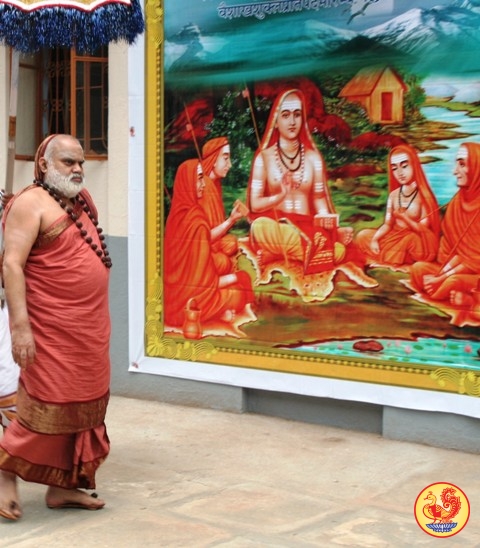
Inspiring Life
Jagadguru Shankaracharya Sri Sri Sri Bharati Tirtha. Mahaswamiji, the present Jagadguru of the Sringeri Sharada Peetham, a sanyasin of the highest paramahamsa order, is arguably the foremost scholar today of Vedanta and sastras.
In 1966, he approached the then Sringeri Jagadguru Sri Sri Sri Abhinava Vidyatirtha Mahaswamiji as a bachelor at the age of 15 seeking his blessings and instruction in the sastras. The Sringeri Acharya was then observing chaturmasya at Ujjain. Sitarama Anjaneyulu (that was the Acharya’s name in his poorvashrama) had come with great vairagya growing in him.
As the great Acharya was returning after bath in the river Sipra, Sitarama Anjaneyulu prostrated before him and sought his tutelage, which was granted. The very next day the Acharya started teaching him. He soon became a gem of a scholar and a dear disciple.
What prompted the boy who had just finished high school studies, and who was advised by his father to go for higher education, to leave his home? Why did he go all the way to Ujjain from his home in Narasaraopet in Guntur District of Andhra Pradesh? It must have been predetermined so by Goddess Sharadamba, the presiding deity of Sringeri Mutt.
When the same question was put to brahmachari Sitarama Anjaneyulu, he replied: “I had the good fortune of having the darshan of the Jagadguru quite early in life. Once I was asked to talk in Sanskrit by my teacher before His Holiness in Vijayawada. I got a special prize from him. At that time, it struck me that His Holiness was my teacher and my saviour. His beaming smile was giving me a message. I thought I got what I wanted.
“His Holiness has since been in my mind always. I used to feel that I was guided by His Holiness whenever there was a problem. This feeling grew in me to such an extent that I could not stay in my place.”
Since then Sitarama Anjaneyulu did not leave the lotus feet of the Acharya. He accompanied the Acharya during all his tours.
Within eight years he finished the study of Krishna Yajur Veda, Purva and Uttara Mimamsa, Nyaya Sastra and many other treatises and commentaries. He also became a poet in Sanskrit.
Childhood Days

Sitarama Anjaneyulu’s childhood is worth recalling in the context of his spiritual background. He was born into a Smartha family bearing the name “Tangirala”, of Apasthamba sutra, Krishna Yajur sakha, Kutsasa gotra, living in Alugumallepadu village in Palnadu area of Guntur, on the banks of river Naguleru. He was born on April 11, 1951 as a result of long prayer and vrata (fast) by his father Venkateshwara Avadhani and mother Ananthalakshmamma. Venkateshwara Avadhani had studied the Vedas , though learning English was the current fashion.
The pious couple desired very much to have a son after begetting four daughters. Avadhani used to wake up early in the morning, bathe in the river and worship Lord Bhavani Shankara, the local deity, with Rudrabhishekha. This he did for a year.
He also used to perform Sri Rama Navaratrotsava. He took a vow to name his child after Sita and Rama if his wish was fulfilled. The Lords Shankara and Rama were kind to him. He was blessed with a son. For her part Smt.Anantalakshmamma had sought Lord Anjaneya’s favour and promised to name the male child born to her ‘Anjaneyulu’. Hence the infant was named Sitarama Anjaneyulu.
Sitarama Anjaneyulu even at the age of three evinced signs of great devotion towards the Gods. The name of Lord Shiva was on his lips constantly. During his boyhood days he used to forget himself worshipping the Lord.
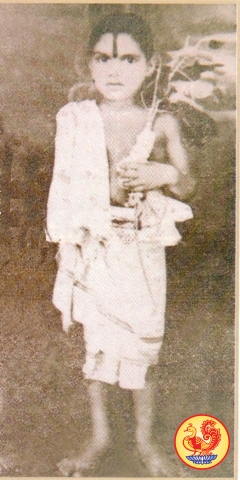
Outside school hours, he always devoted time to Sanskrit studies. By the time he was nine, he had considerable command over the language. He was aware of its subtleties. Scholars and poets, including the Kavi Samrat Sri Viswanatha Satyanarayana, praised him for his eloquence. He won a number of prizes and was invited by All India Radio Vijayawada to participate in Sanskrit programmes.
At night, he learnt the Vedas from his father. He studied Samhita, Brahmana and Aranyaka so well that he could take part in the Guntur District Vedapravardhaka Vidwat Pariksha. He passed the examination with honours.
Command over Languages
Jagadguru Sri Sri Sri Bharati Tirtha Mahaswamiji was seen more often talking in Sanskrit than in Telugu, his mother tongue. Quite early in life, he completed his study of grammar, literature, logic and philosophy. With an inborn love of Sanskrit, he composed poetry at a very early age. Even at games he would talk in verse. Rules of prosody were never violated. Rhyme, rhythm, irony, suggestion: every poetic beauty came naturally to him. Even ordinary things of life found expression in his poetry.
The mastery of His Holiness in Indian languages is well known to devotees. The Sringeri Mutt has under its preview Andhra, Tamilnadu, Karnataka and Kerala. People of these states visit him to pay their respects and are naturally drawn by his amazing versatility in the languages together with a command over the local idiom.
In 1974 on the day in which he was initiated into Sanyasa, His Holiness spoke in Kannada for the first time at the felicitation meeting with such a telling eloquence that all those present, including ministers, High Court judges, members of the Legislature and University professors, could not control their admiration while listening to him. A few months after Sishya Sweekaram both the Holinesses started on a Vijayayatra to Rameshwaram. Enroute at Gobichettipalayam, the Acharya delivered a speech in chaste Tamil, electrifying the devotees as they had never expected such a clear language flow from someone whose language was not Tamil and who had not been taught Tamil by anyone. The eloquence with which he delivers speeches in Telugu, his mother tongue, is indeed a matter of rare experience.
Sri Sri Sri Bharati Tirtha Mahaswamiji accompanied his Guru in his tour of the northern parts of India, and lectured in Hindi. His benedictory speeches were highly appreciated. Even scholars in Hindi language and literature were fascinated with his melodious Sanskritised Hindi.
All his speeches have one thing in common. They are built brick by brick on a sound proposition. They are forceful, thought-provoking and inspiring. The language is always within the reach of the listeners. He reminds us of the ancient sages who taught in the gurukulams.
Devotion to Guru
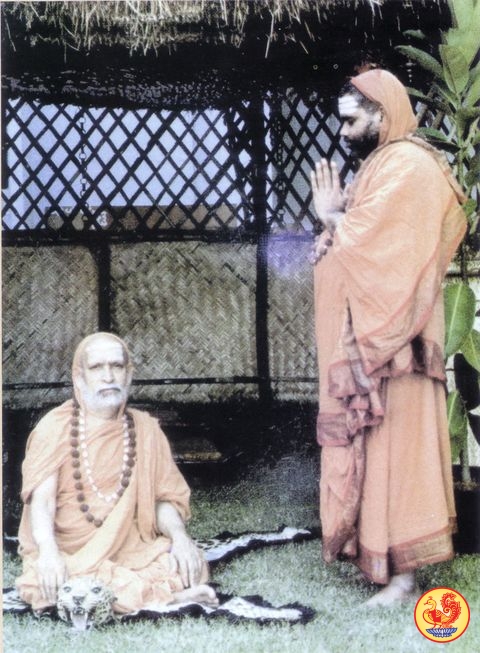
The Guru Gita instructs : “One should meditate on one’s Guru through out one’s life. Even though one enjoys independence, one should not show even a fraction of indifference in one’s attitudes towards one’s Guru.” For Jagadguru Sri Sri Bharati Tirtha Mahaswamiji (also Sri Sannidhanam), His Guru Jagadguru Sri Sri Sri Abhinava Vidyatirtha Mahaswamigal (also Sri Mahasannidhanam) was everything. He never let the fact that He had been given a separate identity as the Peetadhipati, distract Him at any time. Sri Sannidhanam’s mind was ever engrossed on his guru.
Those who have had the great fortune of seeing both the Acharyas together, could have noticed the great reverence with which Sri Sannidhanam conducted himself in the presence of his Guru. Sri Sannidhanam used to visit Sri Mahasannidhanam every morning, offer His prostrations at the most sacred lotus feet of His beloved Guru and only then commence the day’s work. Whenever Sri Mahasannidhanam spoke to Sri Sannidhanam, the latter would reverentially bend forward and listen. Whenever They walked together, Sri Sannidhanam would never over-step his Guru. Whenever both of Them were to occupy Their seats, Sri Sannidhanam would wait for Sri Mahasannidhanam to be seated first. Sometimes when Sri Sannidhanam arrived a little later than Sri Mahasannidhanam to attend a function, He would pay his respects to His Guru first and only then take his seat. Sri Sannidhanam would listen to Sri Mahasannidhanam’s discourses intently. While conducting the Vidwat Sadas (an assembly of scholars), Sri Sannidhanam would ensure that whatever He talked met with Sri Mahasannidhanam’s approval.
Admiring the divine relationship between Sri Mahasannidhanam and Sri Sannidhanam, Dr. Mandana Mishra, a reputed educationalist and Sanskrit scholar, once said to Mahasannidhanam : “We have read that Shankara’s disciple’s went with him. How was He? How were his disciples? I was only conjecturing. Now I have come to the conclusion that they must have been like this. It is so satisfying.”
Ideal Pontiff
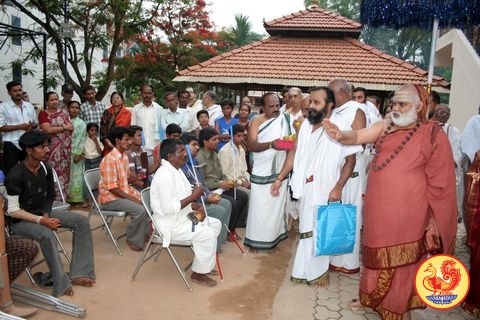
For the convenience of the increasingly large number of devotees and pilgrims coming to Sringeri, the most compassionate Guru, Sri Mahasannidhanam, had decided in the mid 1980s to construct a bridge across the river Tunga to link the Mutt complex on the northern bank with Narasimhavanam on the southern bank. He had entrusted the design and construction of the bridge to a reputed concern with the requisite expertise. The top management of the company held His Holiness in great regard and undertook the task with dedication. Sri Mahasannidhanam lucidly explained the requirements and His conception of the bridge. He unfailingly kept Himself fully posted with the developments. Unmindful of the strain, He regularly visited the construction site, keenly observed the work and, whenever appropriate, proffered encouragement and sagacious counsel. By His grace considerable progress was made by the time He attained Maha Samadhi in September 1989. Actively interested in the quick completion of the noble task commenced by His Guru, His Holiness finally inaugurated the bridge on 21st May 1990. On the day, Sri Sannidhanam named the bridge ‘Vidyatirtha Sethu’.
The Sharada Dhanvantari Charitable hospital run by the Math at Sringeri is the brainchild of Sri Mahasannidhanam who strongly felt that the residents of Sringeri and of the neighboring areas should be given proper medical facilities. The 100-bed hospital received constant attention from Sri Mahasannidhanam who took all steps to modernize it in all respects. Now Sri Sannidhanam, whose very life-breath is the fulfillment of His beloved Guru’s wishes, is taking fruitful steps to add more facilities so that the hospital becomes an ultra-modern health center. The hospital now has separate units for ‘Ayurveda’ and ‘Homeopathy’ too. A ‘Photo Gama Isotope Scanner’ was installed in the hospital in November 1992.
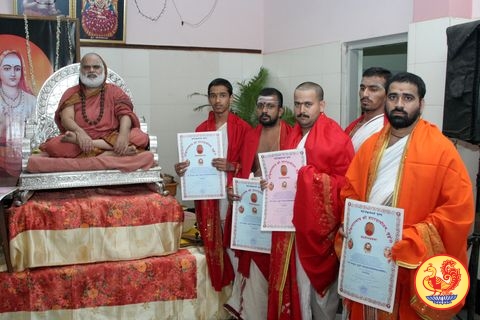
Sri Mahasannidhanam always gave priority to the needs of Vedic Scholars. He was very firm in His view that in order to protect the Vedas, we must protect Vedic Scholars. Sri Sannidhanam is fully aware of His beloved Guru’s praiseworthy intentions. Following Sri Mahasannidhanam’s magnanimous attitudes, Sri Sannidhanam has compassionately announced a lifetime allowance of Rs.1000/- per month to deserving Sastra Pundits. Paying a fitting tribute to Sri Mahasannidhanam, Sri Sannidhanam had a beautiful and majestic granite Adhistanam (Samadhi temple) built at Narasimhavanam. Sri Sannidhanam performed the Kumbabhisheka of the Adhistanam on the 12th of May 1993.
At Sringeri, under Jagadguru Sri Sri Sri Bharati Tirtha Mahaswamiji, the Mutt has undergone many changes. Now one can write to the office in any of the Indian languages, or in English.
Under the directions of His Holiness, a lot of improvement has been made in the Veda Patashalas. Most competent and well-learned Scholars have been appointed to teach the students. Free food, textbooks and comfortable accommodation have been provided to the students. Sri Sannidhanam not merely supervises the schools, but also teaches the senior students. He personally conducts tests, encourages deserving students, tries to help the slow learners and encourages even the teachers through some programmes. The Veda Patashala has been producing competent Scholars who settle down in various parts of the country and serve as Pundits or Purohits. As for performances of Homas and Yagnas Sri Sannidhanam personally supervises them so that the scriptural injunctions are implemented to the last letter. The Mutt conducts Sata Chandi Homas, Sahasra Chandi Homas, Atirudra Homas and the like for the welfare of the world and Sri Sannidhanam, an authority on the scriptures, sees to it that they serve their purpose.
Sri Sannidhanam, being aware of the increasing inflow of pilgrims and devotees, has had new guest houses built and named them ‘Sri Sharada Krupa’ and ‘Yatri Nivas’.
Sri Sannidhanam is accessible to the devotees twice a day, in the morning during the Theertha Prasadam distribution and in the evening. His Holiness receives everyone cheerfully, with a smile. He poses tender questions, listens to what they have to say and offers valuable suggestions. He accepts Bhiksha and witnesses the Pada Puja, which the devotees perform to His Guru’s and to Goddess Sharada’s Padukas.
Even though His daily schedules are very tight, His Holiness attends to all His pontifical duties with admirable enthusiasm and sincerity keeping in mind not only the rich traditional values of the Sringeri Guru Parampara but also the great responsibility entrusted to Him by none other than His peerless Preceptor, Sri Mahasannidhanam.
Scholar Par Excellence
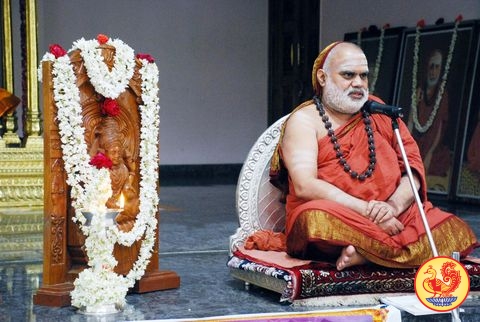
Once, a scholar approached Him and sought clarifications regarding a particular portion in Ghana (a mode of Vedic chanting). Though not having practiced Ghana chanting, Sri Sannidhanam at once recited the same beautifully and the scholar was stunned.
On another occasion, a group of Ghanapatis came for the Darshan of Sri Sannidhanam. His Holiness was pleased to see such learned ones. When He enquired about their studies, the senior-most Ghanapatigal, informed with pride that they all had completed the entire study of Ghana and that they could recite any portion that His Holiness would require them to recite. Sri Sannidhanam was immensely happy at their confidence and asked them to recite a portion of their choice from Vedas. The scholars however insisted that Sri Sannidhanam choose the portion for their recital. With a bewitching smile, Sri Sannidhanam suggested a particular portion. To their own surprise none of those Ghanapatis could recollect and recite that particular portion. Finally, it was Sri Sannidhanam who recited the initial lines of that portion with the appropriate intonation. It was only then that the wonder-struck Ghanapatis could recollect that portion and recite it.
Sri Sannidhanam’s unquestionable scriptural knowledge would be evident to anyone who has watched His Holiness during the Vidwat Sadas dedicated to Lord Ganapati, conducted every year for 10 days commencing on the fourth day of the bright fortnight of the lunar month of Bhadrapada. The Sadas is held every evening in the august presence of His Holiness. Learned scholars and philosophers, invited from all over India and Nepal, assemble in the Sadas. It is customary for each Vidwan to choose some text and analyze it in the mornings with other Vidwans and discuss it in detail in the evenings in the august presence of His Holiness. His Holiness encourages candid communication among the scholars, and intervenes when any issue remains undecided and settles the same in His characteristic style. The most impressive aspect in the Sadas is Sri Sannidhanam’s off-hand quoting of Sastraic passages and His encouragement to young scholars and debutants.
For the past many years, during the Chaturmasya period, His Holiness has been conducting classes in the Brahma Sutras to a select band of sincere devotees. The students invariably assert that they are delighted by the lucid way in which His Holiness makes them understand the text.
Sri Shankara Bhagavatpada in his Mathamnaya Sashana said that any sage occupying the position of the Jagadguru of Sri Sringeri Sharada Peetham in the unbroken apostolic succession is an incarnation of himself. Jagadguru Sri Sri Sri Bharati Tirtha Mahaswamiji is a worthy example.


